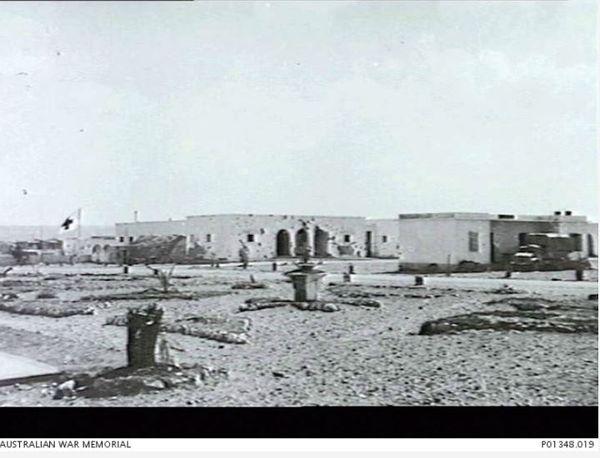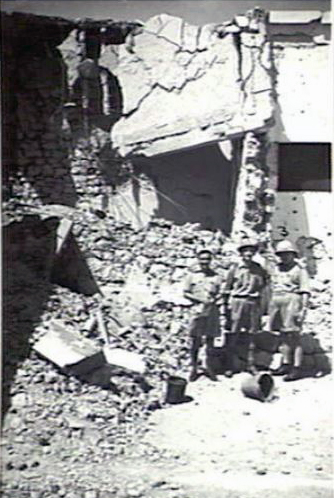Difference between revisions of "2/4th Australian General Hospital"
From Our Contribution
| Line 43: | Line 43: | ||
| − | The hospital then under construction had only one water point and in most other respects was totally unsuitable as a hospital site. However, before the hospital was able to accept patients, it was moved further west, beginning on 28 Feb 1941 when they travelled to Alexandria to board the ''Kight of Malta'' a ship described as a miserable, little evil smelling tub. Destined for Tobruk, she ran aground in very heavy seas somewhere between Bardia and Tobruk on 4 Mar 1941. All survived and were rescued and sent to Bardia. The recovery of over 100 tons of medical supplies requiring the construction of a road to the wreck site took some time and delayed the unit from its objective of setting up a hospital in Barce, in western Libya. Eventually some began to arrive in Barce between 11 and 14 March. After operating for 10 days they were advised to pack up and return to Tobruk as the Germans were massing for a major attack. On 26 Mar 1941 the 2/4th AGH began a withdrawal to Tobruk where it was to remain | + | The hospital then under construction had only one water point and in most other respects was totally unsuitable as a hospital site. However, before the hospital was able to accept patients, it was moved further west, beginning on 28 Feb 1941 when they travelled to Alexandria to board the ''Kight of Malta'' a ship described as a miserable, little evil smelling tub. Destined for Tobruk, she ran aground in very heavy seas somewhere between Bardia and Tobruk on 4 Mar 1941. All survived and were rescued and sent to Bardia. The recovery of over 100 tons of medical supplies requiring the construction of a road to the wreck site took some time and delayed the unit from its objective of setting up a hospital in Barce, in western Libya. Eventually some began to arrive in Barce between 11 and 14 March. After operating for 10 days they were advised to pack up and return to Tobruk as the Germans were massing for a major attack. On 26 Mar 1941 the 2/4th AGH began a withdrawal to Tobruk where it was to remain until 21 Oct 1941. The female staff arrived on 28 Mar 1941, but due to the uncertain military position, they were withdrawn on 7 Apr 1941 aboard the British Hospital Ship ''Vita''. This loss of trained staff had a major effect on the operations of the hospital. From 9 Apr 1941 Tobruk was under siege. On 10 Apr 1941 both the beach section of the hospital, and the main part were bombed and strafed by German aircraft. Several key staff were killed along with 32 patients. While in Tobruk the hospital treated more than 14,000 soldiers, having seen more than 34,000. |
| − | |||
| + | Replaced I Trobuk by a British unit they returned to Alexandria by destroyer, then by truck to Amiriya before boarding a train for an army cam[ at Beit Jirja in Palestine. Following leave they were tasked with opening a hospital in Jerusalem, and began to do so from 13 Nov 1941. All female staff were for the first time included in the hospital. While based in Jerusalem, staff escorted patients by Ambulance Train to El Kantara, across the canal and on to Cairo. On 15 Jan 1942 the 2/4th AGH were told to transfer all patients to the 2/6th AGH and to pack for service in tropical areas. Given the rapid Japanese advances, the 2/4th AGH was held at Kilo 89 in Palestine during the rest of January and into February until on 12 Mar 1942 its main body embarked on ''SS Westernland'' in Port Tewfik. Arriving in Colombo on 25 Mar 1942 it was too late to join the troops for Java (lucky) | ||
| − | + | ||
| + | , 19,000 while at Redbank in Queensland, and another 10,000 in Jerusalem, Colombo and Labaum, Borneo. | ||
==Staff== | ==Staff== | ||
Revision as of 16:00, 16 August 2019
General Information
Staffing increased as men were called up, and then on 11 Jun 1940 the first nursing staff arrived. Initial staff were primarily Victorians, although some were from both South and Western Australia. Intensive training followed along with looking after patients for the Puckapunyal training camp before in November when pre-embarkation leave was granted. On 29 Dec 1940 the unit embarked on SS Mauritania as part of convoy US 8. Other ships were the Queen Mary, the Aquitania, Dominion Monarch', and the Awatea
After a short stay in Fremantle (2 - 4 January) the convoy sailed to Ceylon, arriving there on 11 Jan 1941. On 15 Jan they were transferred to the HMT Y3 Nevasa, one of 15 smaller ships that transported the troops to Egypt. On arrival in Egypt the nurses were detached to assist the 2/2 AGH which was busy treating patients from the Western Desert campaign against the Italians. The male members of the unit disembarked at Port Tewfik on 2 Feb 1941 and travelled by train to Abd El Kadr in the Amiriya district west of Alexandria.
The hospital then under construction had only one water point and in most other respects was totally unsuitable as a hospital site. However, before the hospital was able to accept patients, it was moved further west, beginning on 28 Feb 1941 when they travelled to Alexandria to board the Kight of Malta a ship described as a miserable, little evil smelling tub. Destined for Tobruk, she ran aground in very heavy seas somewhere between Bardia and Tobruk on 4 Mar 1941. All survived and were rescued and sent to Bardia. The recovery of over 100 tons of medical supplies requiring the construction of a road to the wreck site took some time and delayed the unit from its objective of setting up a hospital in Barce, in western Libya. Eventually some began to arrive in Barce between 11 and 14 March. After operating for 10 days they were advised to pack up and return to Tobruk as the Germans were massing for a major attack. On 26 Mar 1941 the 2/4th AGH began a withdrawal to Tobruk where it was to remain until 21 Oct 1941. The female staff arrived on 28 Mar 1941, but due to the uncertain military position, they were withdrawn on 7 Apr 1941 aboard the British Hospital Ship Vita. This loss of trained staff had a major effect on the operations of the hospital. From 9 Apr 1941 Tobruk was under siege. On 10 Apr 1941 both the beach section of the hospital, and the main part were bombed and strafed by German aircraft. Several key staff were killed along with 32 patients. While in Tobruk the hospital treated more than 14,000 soldiers, having seen more than 34,000.
Replaced I Trobuk by a British unit they returned to Alexandria by destroyer, then by truck to Amiriya before boarding a train for an army cam[ at Beit Jirja in Palestine. Following leave they were tasked with opening a hospital in Jerusalem, and began to do so from 13 Nov 1941. All female staff were for the first time included in the hospital. While based in Jerusalem, staff escorted patients by Ambulance Train to El Kantara, across the canal and on to Cairo. On 15 Jan 1942 the 2/4th AGH were told to transfer all patients to the 2/6th AGH and to pack for service in tropical areas. Given the rapid Japanese advances, the 2/4th AGH was held at Kilo 89 in Palestine during the rest of January and into February until on 12 Mar 1942 its main body embarked on SS Westernland in Port Tewfik. Arriving in Colombo on 25 Mar 1942 it was too late to join the troops for Java (lucky)
, 19,000 while at Redbank in Queensland, and another 10,000 in Jerusalem, Colombo and Labaum, Borneo.
Staff
Patients
1941 Tobruk
- Alfred George Playle 2 May - 25 Jun 1941
- Douglas Edward Cleave Steer 2 - 7 May 1941
- Andrew Walker Cunningham 8 - 21 Aug 1941
- Douglas Edward Cleave Steer 30 Aug - 6 Sep 1941

